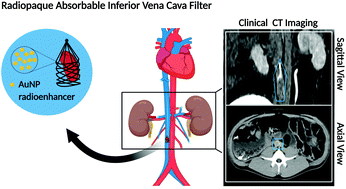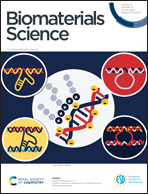In vivo performance of gold nanoparticle-loaded absorbable inferior vena cava filters in a swine model†
Abstract
Absorbable inferior vena cava filters (IVCFs) offer a promising alternative to metallic retrievable filters in providing protection against pulmonary embolism (PE) for patients contraindicated for anticoagulant therapy. However, because absorbable filters are not radiopaque, monitoring of the filter using conventional X-ray imaging modalities (e.g. plain film radiographs, computed tomography [CT] and fluoroscopy) during deployment and follow-up is not possible and represents a potential obstacle to widespread clinical integration of the device. Here, we demonstrate that gold nanoparticles (AuNPs) infused into biodegradable filters made up of poly-p-dioxanone (PPDO) may improve device radiopacity without untoward effects on device efficacy and safety, as assessed in swine models for 12 weeks. The absorbable AuNP-infused filters demonstrated significantly improved visualization using CT without affecting tensile strength, in vitro degradation, in vivo resorption, or thrombus-capturing efficacy, as compared to similar non-AuNPs infused resorbable IVCFs. This study presents a significant advancement to the development of imaging enhancers for absorbable IVCFs.



 Please wait while we load your content...
Please wait while we load your content...